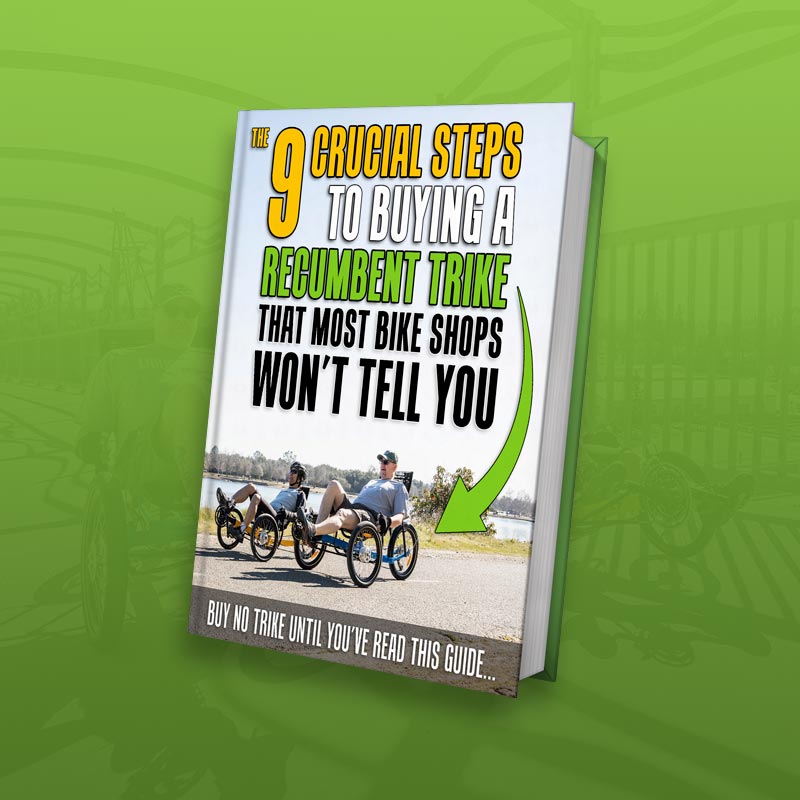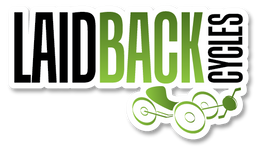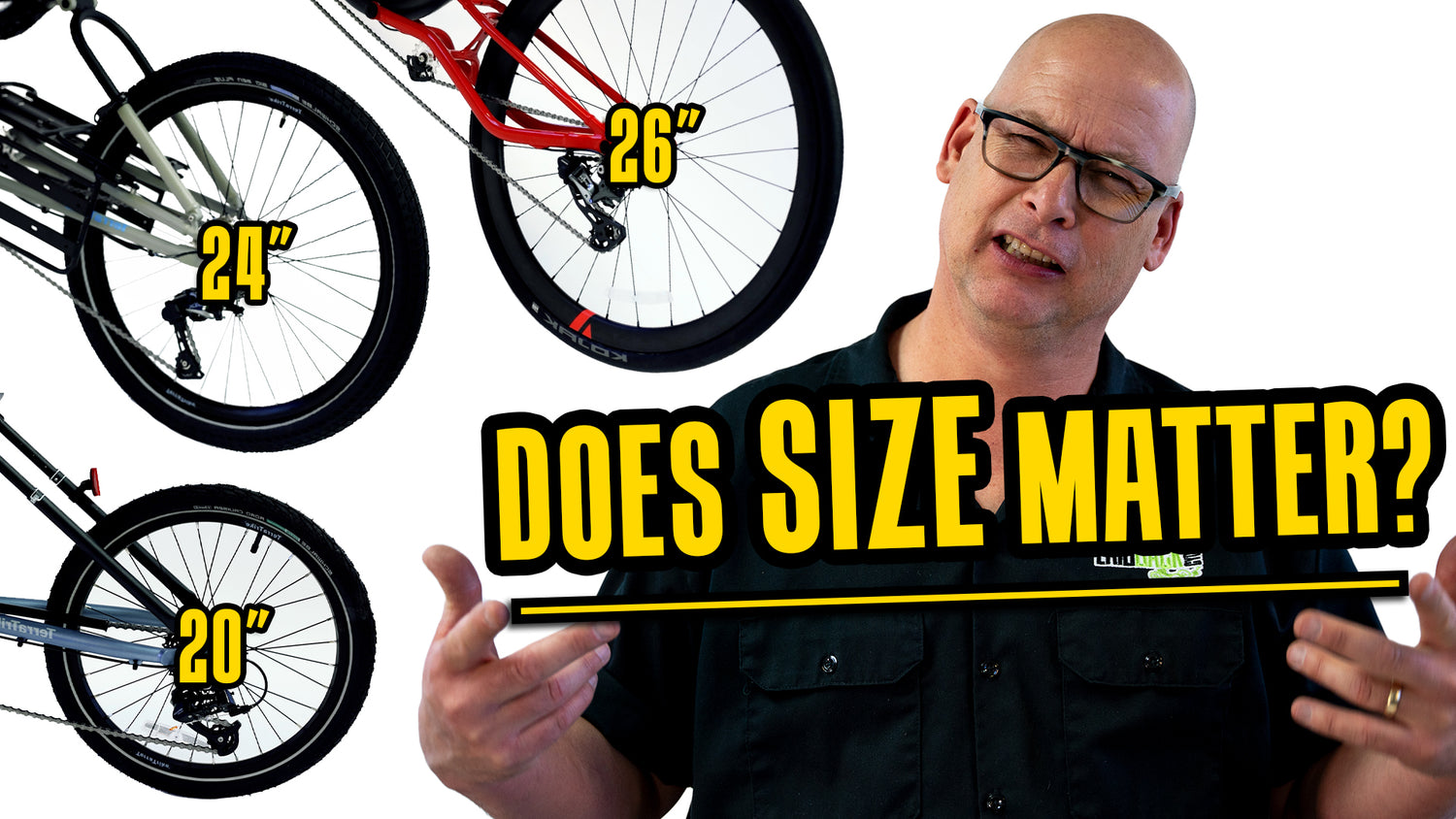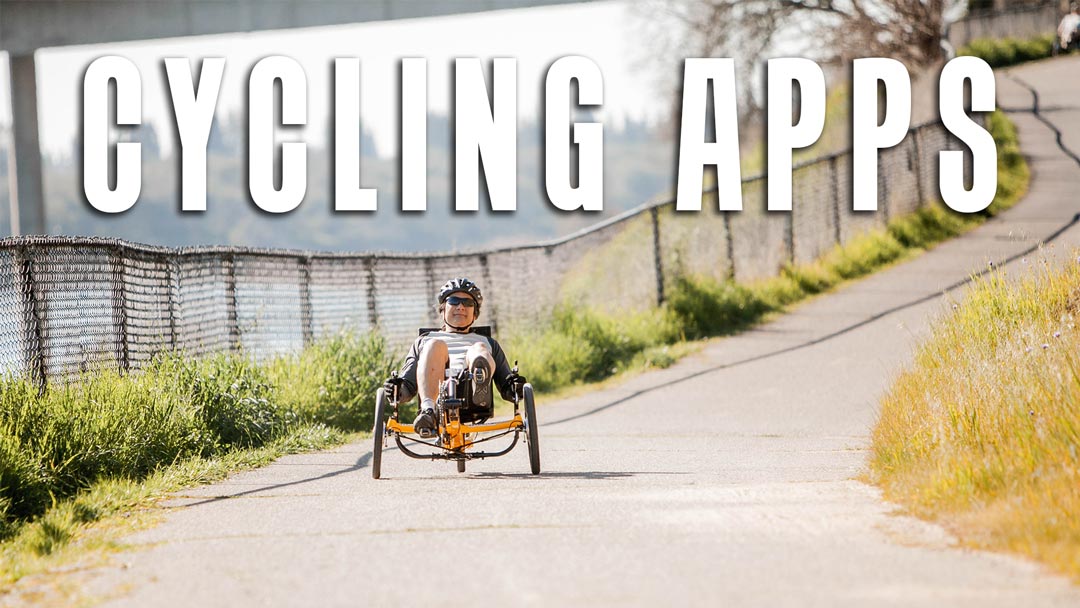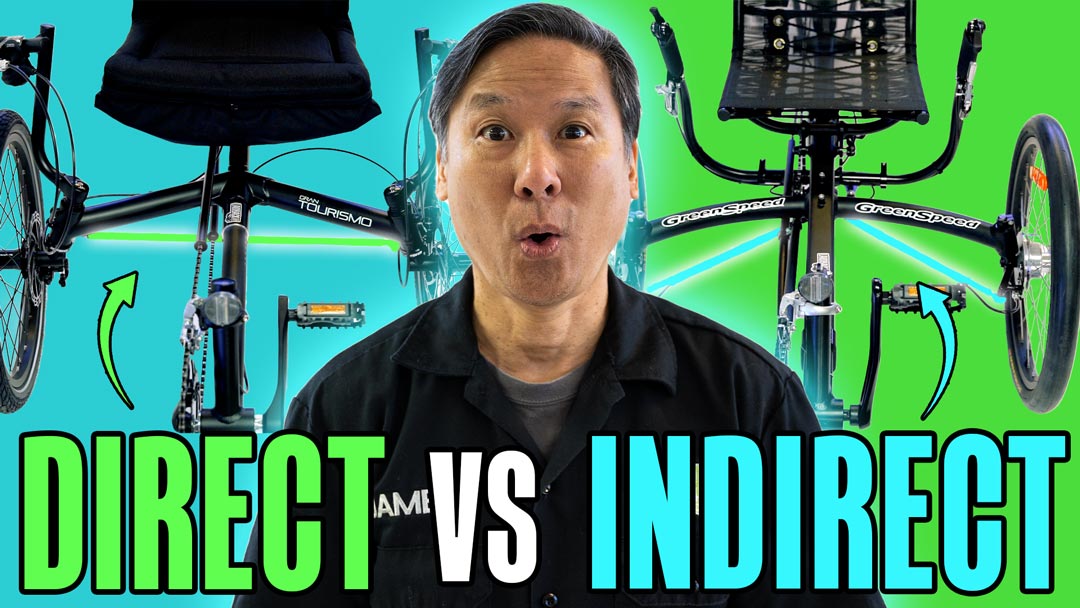Does Size Matter for Trike Wheels?
There are a lot of things to consider when buying your first recumbent trike. One thing that might have you stumped is whether the size of the trike wheels matter. What’s better? How does size impact the ride, safety, or even the look of the trike? There are many questions about wheel size you might want to be answered. Here we explain why you might consider one size over another with a technical overview broken down into layman’s terms.
What Do You Want From Your Ride?
We always tell our customers the type of trike features they choose all depend on what they want from their ride. For example, if you want the fastest ride possible, you’re looking at a 26-inch fast wheel. That’s because as soon as you put your foot on the pedal, it does a full rotation, so it pushes farther and faster. If you love the challenge of steep hills or happen to live in a particularly hilly area, a 20-inch wheel, with the small size and right gear ratio, allows you to climb hills with less effort. If you want a little of A and a little of B, the 24-inch wheel is right in the middle.
Is It Just About the Wheels?
That’s a good question. The gearing can help compensate for any wheel size. For example, a trike that has 16-inch wheels, in theory, are too small if you want to go fast. However, it is fast because it has the right gearing to go with it. As a result, it provides the speed and handling we love.
Wheel size does impact how a trike works, but manufacturers compensate for any possible challenges using gearing. It really has more to do with the trike design rather than just the wheel size. The wheel size makes some difference, but it is not everything. And that’s why you’re probably not going to feel much difference just by changing out the wheel.
Gear is not the only thing manufacturers consider. The wheel also affects how the designers make the frames. For example, a race trike has a longer wheelbase that tracks straighter at the expense of handling. As a result, a trike like the GTS has a slightly shorter wheelbase. They still use a larger wheel, which has more to do with options for gearing. With standard gearing and a 20-inch wheel, you’re not going to get your speed higher than 18 to 20 miles an hour. Most of us don’t go that fast, so it’s not a problem. But for the real speedsters out there, it can make a real difference, especially going downhill.
Why is Gear So Important?
Gear is important because wheel size can limit gearing capabilities. Smaller wheels put limitations on gearing. As a result, choosing the wrong gear can mean you don’t have enough chain. For example, a 20-inch wheel is better if you need low gears for things like toting heavier loads or hitting hilly trails. You need more leg power, so lower gears are best. If you need higher gears, the 26-inch wheel is better at holding higher speeds, especially on rougher terrain. You’re looking at a 700c for a racing bike, as they are the fastest around while making high gears easier to access.
How Does Wheel Size Impact the Look?
When it comes down to it, it often is all about looks. Before even worrying about wheel size, check out the trikes on display and decide which one appeals to your sense of aesthetics. Then you can find out the wheel size and other components to see if it’s a good fit. If this isn’t important to you, you can focus on other features to help narrow down your choices.
Other Considerations for Wheel Size
There are a few other considerations when it comes to wheel size. For example, some people like a 20-inch wheel on the front and the back. Why is this such a big deal? You can carry one tube in your emergency repair kit for flats instead of needing two tubes for a 20-24 or 20-26 inch trike. It’s not a big thing, but it does make it more convenient.
You also have to consider the overall size of the trike in relation to your vehicle or your storage space. The 20-inch is going to be the shorter one, so that’ll be easier to fit in the car or in a smaller apartment. If you want a larger wheel, it’s only going to fit in something like an SUV or pickup truck unless you go for a trike that folds. The folding trike is becoming more popular as people opt for smaller living spaces and smaller fuel-efficient vehicles.
What About the Front Wheels?
Another great question. Recumbent trike front wheels normally come in one size -- 20-inch. This is because the smaller size tends to be stronger. When you consider how you ride the trike, the front wheels face higher forces than the wheels at the back. Because of this, if the wheel on the front was larger, it wouldn’t have the resistance required to stand up to things like turns.
Remember, recumbent wheel size is a decision made by engineers who understand how the front wheel stands up to the punishment of even the harshest ride. As a result, there’s a lot of thought put into wheel design and diameter. Every detail of the wheel impacts performance and strength, including spoke angle and size. So, what we’re saying here is, if, for some reason, you have a sudden urge to replace your 20-inch front wheel with a bigger front wheel, resist the urge. It’s all about balance, strength, and engineering when it comes to front wheels.
There you have it. Wheel size does matter, and it all depends on the type of ride you prefer. The larger the wheel, the faster the speed and the smaller the wheel, the less effort it takes to tackle things like hills or heavy loads.

Video Transcript
Laid-Back Mickey here, going over does size matters in wheels? 20-inch wheels, 24-inch wheels, 26-inch wheels, what does it matter and why would you want to get one over the other? In this video we will have a special guest, Master Tech James, go over the technical side of the wheel choosing process. So, let’s check it out and here we go!
People ask me all the time, “What’s the difference between a 20-inch wheel, a 24-inch wheel, and a 26-inch wheel” and “Why would I want one over the other?” I have a lot of people go “I want the fastest wheel possible.” So, I say, maybe we’re going into a 26-inch fast wheel that right when you push the pedal it’s doing a full rotation and it’s pushing off further. Some people will say that they need to climb hills a lot better and a 20-inch wheel, with the small size and the gear ratio, allows you to climb the hills a little better. And the 24-inch wheel is right in the middle. It’s that simple, but the gearing can be compensated for any of the wheels. So, one of my favorite trikes was a Green Speed GT and that one had 16-inch wheels. It was fast, but it had the right gearing to go with it. When it comes down to it, it’s about the looks. You figure out if you like the look of a 26-inch or 20-inch. Do you like the fact that a 20-inch has a 20-inch on the front and the back, which that allows you to carry one tube compared to a 20-24 or 20-26 inch which makes you have to carry two tubes when you are out on the road in case you get a flat tire? Which, hey, get thorn resistant tires if you don’t want a flat tire. And the cool thing is that some people ask “which one fits easier in my car?” Well, the 20-inch is going to be the shorter one so that’ll be easier to fit in the car. With the 26-inch you’ll have to either have a small SUV or maybe you get one that folds in order to fit it inside. Now let’s go ahead and talk to Master Tech James and see what the technical side of it is.
Hi, I’m James the Master Technician of Laid-Back Cycles. So, the wheel size from a technical aspect does have little consequences on how they work. But in the big picture it doesn’t matter because the manufacturers compensate by gearing and it really has more to do with the trike design rather than just the wheel size. The wheel size makes some difference, but it is not everything. And that’s why the vast majority of us don’t really feel a whole lot of difference just by changing out the wheel. However, the wheel does affect how the designers make the frames. Like this race trike over here, longer wheelbase things track straighter at the expense of handling. Which is why the GTS has a slightly shorter wheelbase. They still use a larger wheel and that has more to do with options of gearing. With a standard gearing and with a 20-inch wheel we find 18 to 20 miles an hour is as fast as you’re going. Most of us don’t go that fast so it’s not a problem. But for the real speedsters it can make a real difference, especially on a downhill. So, it is easy to go into a rabbit hole on wheel sizes, but the truth is most of the manufacturers pick specific wheel sizes for what they are doing with the trikes. The number one reason that people get larger wheels in our experience is it looks good.
Thanks James for the technical side of dust size matter and wheels. So, 20-inch wheels will help you go up the hill easier and 26-inch wheels will help you get going faster from the get-go. But you know, what if you don’t have the strength to go up the hill, what if you don’t have the strength to go faster, and you want to keep up with your friends? Check out this next video and I’ll show you how you can go up hills faster, keep up with your friends better, and we will see you on the next video.
